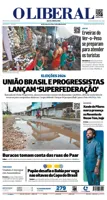Covid-19 in the Amazon: even with a high number of cases and deaths, vaccination is below average
If it were a country, the Brazilian Legal Amazon would occupy the 17th position among the nations with the largest number of confirmed cases and deaths by Covid-19
Although the rate of confirmed cases of Covid-19 in the Amazon being higher than the national average, the vaccination rate in the nine states that make up the region is still lower than the average rate in the rest of the country.
According to data from the Health Surveillance Secretariat, from the Ministry of Health, from March 2020 to May 2021, the Amazon has already accumulated more than 2 million confirmed cases of the disease, generating an incidence rate of the disease in relation to the population of 7,500 cases for every 100,000 inhabitants.
The average incidence rate in Brazil was 6.9 thousand cases per 100 thousand inhabitants, in relation to the population with an accumulated total of 14.7 million cases in the country since the beginning of the pandemic.
Listen to the comment on this news:
Still, according to the Secretariat of Surveillance, the mortality rate in the Brazilian Amazon region is 195.4 deaths for every 100 thousand inhabitants, while the national average in this same item was 191.1 deaths.
When it comes to Covid-19 data in the world, compiled by “Our world in data”, from the University of Oxford, the Brazilian Amazon, if it were a country, would occupy the 17th global position, both in number of deaths (54 thousand) as in the number of confirmed cases (2,082,068).
Considering only the estimated population of 25 million inhabitants, the Amazon would be only the 56th country in the world in terms of inhabitants and the sixth largest in the world in terms of land area.
Brazil currently occupies the third position in number of cases of Covid (15.2 million) and the second position in number of deaths, with more than 425 thousand lives lost to the disease.
While the disease indicators in the region are higher than the Brazilian national average, the rate of vaccination in the Amazon remains below the country's average index. According to data from the media consortium, based on daily reports by the health departments from each Brazilian state, until May 10, 2021, 12.5% of the population of the states that make up the Brazilian Legal Amazon received at least one dose of vaccines available against the Coronavirus, while the national average is 16.6%.
Regarding the numbers of those who have already received the second dose of the immunizer, the Amazon was also below the national average, with only 6.15%, while the national average is at 8.3%.
To expand the supply of vaccines and to accelerate the rate of vaccination, the governors of several Brazilian states are looking for alternative offers of the immunizer. The country currently has shots from Pfizer (BioNtech), Astrazeneca (Oxford / Fiocruz) and Coronavac (Butantan / Sinovac).
One of the initiatives is the purchase of Sputinik, which was banned by the National Health Surveillance Agency (Anvisa), which claimed technical criteria for refusing to import the immunizer.
At the beginning of the month, the governor of Pará, Helder Barbalho and the governor of Piauí, Wellingtom Dias, were with the Russian ambassador in Brazil, Alexey Kazimirovitch, to address the issue.
"The goal is that we can mediate and facilitate the dialogue between the Brazilian Surveillance Agency with the Gamaleya Institute (responsible for the research on the Russian vaccine). The intention is that, having clarified doubts and showing the effectiveness of this vaccine, which is already being applied in 62 countries, we can increase the supply of vaccines (in Brazil) with Sputnik. In this way, we will increase the quantity of vaccines available to the Brazilian population ", informed the governor of Pará.
Amazon region has the worst medical density in the country
In addition to the well-known logistical difficulties in serving remote communities and the lack of prioritization for serving the population in the Amazon, the region faces structural and historical health problems, such as the low supply of equipment in relation to other regions in the country, as well as few doctors in relation to the population.
"The Amazon region is wide, where services and professionals don’t last long, do not remain to assist the needs of the population, especially the riverside", highlights Vanja dos Santos, who is part of the National Health Council.
According to the study "Medical Demography in Brazil 2020", prepared by the Federal Council of Medicine (CFM) and the University of São Paulo (USP), released at the end of last year, the North region, house to seven of the nine States of the Legal Amazon, registers the worst index in the country, with 1.3 doctors per thousand inhabitants.
The index is well below the national average, which is 2.2 doctors per thousand inhabitants. Across the country, Pará, with 1.07, and Maranhão (which partly integrates the Legal Amazon), with a rate of 1.08, are the states with the lowest number of doctors in relation to the population.
According to a survey, “when comparing the proportion of doctors and the population, inequalities are even more evident. The North region, for example, groups 8.8% of the entire population of the country, but it has 4.6% of doctors in activity ”, highlights the study.
When looking at the interior of the country, the scenario gets even worse. While in the group of Brazilian capitals there are 5.6 doctors per thousand inhabitants, the cities in the countryside had an average of 1.4 doctors per thousand inhabitants. The picture is also even more alarming among the states of the Brazilian Amazon. The North region has a ratio of only 0.54 doctors per thousand inhabitants when considering the cities in the countryside of the region.
Region has the lowest rate of doctors training in the country
Also according to the study "Medical Demography in Brazil 2020", the distribution of seats in medical universities is also uneven in Brazil. The North region, again, has the worst index among the regions, with 3,013 available seats, or 8% of the total of 37,823 available seats in the country. Southeast Brazil, formed by São Paulo, Rio de Janeiro, Minas Gerais and Espírito Santo, concentrates 46%, totaling 148 courses and 17,404 available seats.
Across the country, 62.6% of medical undergraduation seats offered are in the countryside of the states. The rate of interiorization, however, falls by half in the North, with 32.3% of vacancies offered by courses located in the interior.
One of these cities is Santarém, in the west of Pará, in the heart of the Amazon. The medical undergraduate at the University of the State of Pará (Uepa) formed its first class in 2012. The investment in higher education in the interior shows results in practice, including in the current scenario of combating Covid-19.
Doctor Eduardo Maia graduated on April 30 this year. The next day, he presented himself to act on the front line of the pandemic, at the Santarém field hospital, a city where he was born, grew up and formed.
"Completing the course in a pandemic scenario was unexpected. The party, the ceremony, was dreamed of for years by my entire family, but it was left out. We live in a scenario where the city needs doctors. We exchange any party or ceremony for the cause. It was not the graduation I wanted, but it was what my city needed. It is a daily challenge and an honor. I have had to intubate relatives and I have seen familiar faces that have become statistics. It is a hard time, but there is no lack of courage and commitment from health professionals", reports Eduardo.
“I believe that a good part of the positive result, of the deaths that we avoid, is a lot due to the practice and knowledge that we acquire here, valuing each life. The front line does not give up on a single patient, at any time and it is a mixture of feelings, since we are sad with some losses, but happy with cases of recovery and medical discharge ", emphasizes the young doctor.
From rubber soldier to Covid-19 survivor
One of those moments of joy during the effort of attending the pandemic occurred a few days ago, when Eduardo, only 25 years old, drove out the hospital - through the front door - Mr. Augusto Menezes, 105, who won Covid-19 after ten days of treatment.
“In the first days he was very distressed, but we did an integrated work with nursing, psychosocial and medical teams and then he was able to collaborate and had a recovery improvement very quickly”, reports Eduardo.
The retiree worked in several professions throughout his life. One of the most memorable was the period in which he worked with the extraction of latex, taken from the rubber tree, in the 1940s. These professionals were known as “rubber soldiers”, as they helped to supply the raw material used during the Second World War for Allied vehicles, especially the United States.
Augusto has lost count of how many times he got infected with malaria during that time, a characteristic disease of the region that killed thousands of other “rubber soldiers”, a story little known globally.
Now, Augusto proudly places in the “curriculum of overcome diseases” another victory: he is one of the survivors of Covid-19. “We are all very happy with his return home. He, who also worked as a bricklayer, was always very active. He likes to be productive. We are all very grateful for the treatment he received at the hospital, as this was the first time he was hospitalized. At first, he was very reluctant to stay in the hospital, but the team calmed him down and now he is even happier to have beaten Covid and back home”, says Patrícia Sales Lira, Augusto's granddaughter.
The former rubber tapper, a native of the state of Ceará, went during his youth t the Amazon, where he started a family: currently, there are eleven children, 38 grandchildren and 50 great-grandchildren.
“He is doing very well and we are waiting for the second dose of the vaccine. When he contracted it, he had only taken the first one, so he was not fully immunized. We do everything to keep him at home, not expose himself, but he is very active. Anyway, he is happy with life and we realize that it is as if he was born again, even at 105 years old ”, comments the granddaughter.
Palavras-chave
COMPARTILHE ESSA NOTÍCIA
































